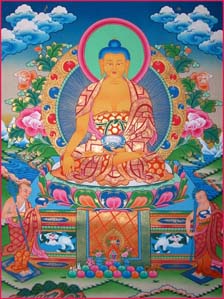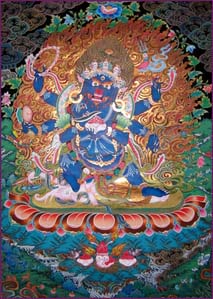
East Hamilton High School
Teacher
Tales Within The ThangkasWhen Buddhism made the tectonic shift from India to Tibet in 1200, synoptic art crashed out of the restraints of rock and stone and burst forth in raging, blazing, sometimes wrathful, Technicolor. Like the refracting rainbows that dance off the Himalayan snows, Tibetan thangkas exploded into psychedelic splendor. Overwhelming and even distracting, thangkas pushed the sensory envelope to welcome in a host of deities, learned bodhisattvas, and celestial buddhas. Barely contained on flexible canvases, thangka painting’s dizzying style is still meant to be more than simply eye candy. As Buddhism grew into different schools and moved geographically, especially through Nepal and Tibet, the religion picked up elaborate complexities and a myriad of new role players. The Great Path, it turns out, was jammed with new traffic.The hyperkinetic images of Tibet's thangkas, then, are intended to organize and lend structure to an extremely crowded cast of gods, goddesses, buddhas, bodhisatvas, arhats, llamas, and on and on. There is, in short, a distinctly Eastern methodology to what might seem madness to Western mindsets. As Rober Fisher explains: "Such secret doctrines, visualizations and magical powers (of Mahayana and Vajrayana) were not things that could easily be spelled out in texts and (the) literature remains as complex and mysterious as any in the world's religions. (19) The need to harness the myriad powers and organized the parts of this vast system into a manageable whole required a large and complex visual system of support ... (21)." Art of Tibet Thangkas are not simply focusing objects for meditation, not simply primordial graphic novels of Shakyamuni's life, not simply placecards for some celestial roll call. They are roadmaps to The Great Path that had grown from The Middle Way. David Jackson contends that while thangkas may appear complex to the uninitiated, once a viewer learns to recognize and read the recurring motifs, the paintings become downright predictable. Thangkas, Jackson maintains, are simply a logical incarnation of visualized texts. "A painting of this tradition has its rules of grammar ... which allow one to interpret its arrangements systematically. As in many written languages, one can distinguish in a painting several levels of description such as those corresponding to letters, words, and sentences. To follow the analogy of language and reading, the sacred figures in a thangka could be considered to be like the words in a language. The individual attributes of a figure -- i.e. the iconographic elements such as colors, hand gestures, dress, ornamentation, etc. -- are like the letters of the words. And to determine the correct ordering of the figures, there are the rules governing composition -- corresponding to rules of syntax ..." For a deeper look at exactly how Jackson breaks down the structure and iconography of these texts masquerading as images, read Lineages and the Principals of Composition in Tibetan Buddhist Paintings: Reading Tibetan Thangkas as Records. In her article, Decision from Indecision:Conservation of Thangka Significance, Perspectives and Approaches, Jacinta Boon Nee Loh looks at the tradition of creating these pieces as well as the challenges facing those attempting to save them. For wide range of examples, take a look at this Thangka PowerPoint. In no way intended to cover all variations and styles of thangkas, this slideshow simply offers a glimpse into the many different representations of the art form.
|
This site was created by [Susan Morrison ] at the NEH Summer Institute "Literatures, Religions, and Arts of the Himalayan Region," held at the College of the Holy Cross, Summer 2011.




